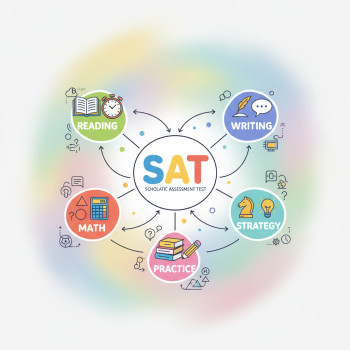Why this guide matters: calming the deadline chaos
Senior year arrives with a mixed cocktail of excitement, pride, and a daunting inbox of deadlines. For parents, the scramble to keep track of application windows, test reporting, essays, recommendation letters, and financial aid can feel overwhelming — especially after the Digital SAT sits on the transcript and the next question becomes: what now?
This guide walks you through an organized, practical approach to managing application deadlines after the Digital SAT. Think of it as a calm, parent-centered playbook: clear timelines, realistic checklists, examples, and gentle ways to coach your student without taking over. We’ll also show how to use reasonable tools and resources — including targeted help like Sparkl’s personalized tutoring — when your teen needs 1-on-1 guidance or an expert nudge.
Top-level timeline: key milestones after the Digital SAT
Most U.S. colleges accept applications on a rolling or fixed schedule. Many deadlines cluster in early November for Early Decision/Early Action and January–February for Regular Decision. Your family’s action plan depends on the application types your teen chooses, but the high-level milestones are consistently useful for planning.
Simple milestone checklist
- Immediately after final SAT attempt: confirm score reporting and transcript timing.
- August–October (Senior year): open Common App/Coalition account, polish résumé of activities, begin essay drafts.
- Early November: Early Decision/Early Action deadlines (if applicable).
- January–February: Regular Decision deadlines for many colleges.
- February–March: FAFSA and financial aid forms (note opening dates each year).
- March–April: Admission decisions and comparing offers.
- May 1: National decision day (typical deadline to accept offers).

Step-by-step: building a family calendar that actually works
A living calendar — simple, visible, and shared — is the single best defense against missed deadlines. Here’s how to build one that balances oversight with teenage independence.
1. Choose the calendar format
- Physical large wall calendar in a shared space (visible daily reminders).
- Shared digital calendar (Google Calendar or family-shared calendar) for reminders, alarms, and attachments.
- A project-tracking sheet (spreadsheet or planning app) that lists each college with every deadline and status.
2. Populate with firm dates (example table)
Start with known dates: application types, test report deadlines, counselor recommendation deadlines, and financial aid forms. Use this example table as a template to copy into your planner.
| Item | Typical Deadline Window | When to Complete (Suggested) | Who Is Responsible |
|---|---|---|---|
| Early Decision / Early Action | Late October – Early November | Complete by mid-October | Student with parent reminders |
| Regular Decision | Jan 1 – Feb 28 (varies) | Complete by 2–3 weeks before deadline | Student submits; parent verifies |
| FAFSA / Financial Aid | Opens Oct 1 each year; deadlines vary by state | Gather documents in September; submit Oct–Nov | Parent + student |
| Teacher Recommendations | Depends on college | Ask teachers by September; reminders 4 weeks before | Student asks; parent supports logistics |
| SAT Score Reports (if sending) | As needed; allow processing time | Request immediately after scores are final | Student (parent verifies) |
3. Assign roles and defaults
Clarify who does what: who keeps the master calendar, who uploads transcripts, who follows up on recommendations. A helpful default: the student drives content and submission, parents manage deadlines and logistics. That balance preserves ownership while preventing oversights.
Navigating different application types
Different application routes change the urgency. Knowing how they differ helps families prioritize.
Early Decision (ED)
Binding commitment to attend if admitted. Deadlines are early (often early November). Encourage your teen to apply ED only if they are sure the school is the top choice and finances are clear. Parents should verify financial aid timing before agreeing to ED.
Early Action (EA)
Non-binding, early notification. Deadlines similar to ED but without the binding commitment. Good for students who want an early answer without committing.
Regular Decision
The big chunk of applications falls here with deadlines through January–February. The trick is not to wait until the last minute — colleges may take longer to process late files.
Score and transcript logistics after the Digital SAT
Even if the Digital SAT is complete, administrative tasks remain. Confirming score reports and timing transcripts matters because colleges consider complete applications only when all components arrive.
Practical tips
- Log in to the College Board account and confirm which scores will be sent and when. For some students, super-scoring or selective reporting matters — make the choice together.
- Request official transcripts early. Counselors get busy; give them at least two weeks plus buffer time for mailing or electronic delivery.
- Keep copies of confirmations and submission receipts. Screenshot and store in a shared folder.

Essay, recommendation, and portfolio timelines
Essays and recommendations are the human heart of the application. They take time, multiple drafts, and gentle coordination with teachers and mentors.
Essay workflow
- Brainstorm in August–September; collect writing prompts for each application.
- Draft in September–October; aim for multiple revisions.
- Get feedback from trusted adults, teachers, or a professional tutor.
- Finalize at least one week before the earliest deadline.
Recommendation letters
Students should ask teachers at least one month before the first deadline, and provide a one-page packet: updated résumé, brief note on focus areas, and the deadline. Parents can help by gently following up with thank-you reminders — but the initial ask should come from the student.
Financial aid and scholarships — timing parents can’t ignore
Financial aid timing often runs parallel to admission deadlines. Missing financial forms can delay or reduce offers.
Key financial milestones
- FAFSA opens each October (collect W-2s, tax returns, Social Security numbers beforehand).
- CSS Profile (if required) opens in the fall; many private colleges use it for institutional aid.
- State and college-specific deadlines vary — check each college’s financial aid page early.
Helping without hovering: communication strategies for parents
Balancing support and independence is the emotional art of this phase. Teenagers need autonomy to grow, while parents provide structure and safety nets.
Communication approach
- Weekly check-ins: schedule a 20–30 minute weekly session to review progress and update the calendar.
- Use encouraging language: “What do you want me to help with?” is better than “Have you done X?”
- Assign responsibilities: let the student be responsible for content; the parent verifies logistics and deadlines.
- Be the buffer: handle administrative calls and follow-ups with the counselor when needed.
When to bring in extra help
Sometimes an application bottleneck needs an expert intervention: an essay stuck in draft purgatory, procrastination, or confusion about test reporting. That’s when targeted support pays off.
Signs your teen may benefit from tutoring or coaching
- Essay drafts going nowhere after multiple revisions.
- Missed or forgotten internal deadlines within the household.
- High stress or anxiety blocking progress.
- Uncertainty about which test scores to send or how to present extracurriculars.
Services that offer 1-on-1 guidance, tailored study plans, and expert tutors (plus AI-driven insights for practice and time management) can accelerate progress and reduce worry — particularly when time is tight. When used sparingly and strategically, personalized tutoring becomes a planning tool rather than a crutch.
Sample four-week sprint before an early deadline
If a school’s Early Action deadline is looming, here is a focused, parent-friendly four-week plan to get everything submitted.
Week-by-week plan
- Week 1: Finalize essay draft; ask teachers for recommendations and confirm they’ll submit online; request transcript.
- Week 2: Incorporate final edits; complete all application forms and activities list; verify essay word counts and school-specific prompts.
- Week 3: Upload essays, submit application, and pay fees (or apply for a fee waiver). Confirm recommendation submission. Request score reports if needed.
- Week 4: Double-check all confirmations; print or save receipts; send thank-you notes to recommenders; confirm college portal shows materials received.
Practical examples: how families solved common bottlenecks
Real-world examples make abstract advice concrete. Here are three short scenarios and how a solution unfolded.
Example 1: The missing recommendation
Problem: A teacher promised a letter but the application portal still showed “not received” three days before the deadline.
Solution: The parent reached out to the counselor to request the school submit a counselor letter and transcript electronically; the parent and student also politely confirmed with the teacher by email. The counselor submitted an interim transcript and the teacher uploaded the letter the next day. The family avoided panic by escalating politely and using the school’s official channels.
Example 2: Essay stuck and deadline looming
Problem: The student had a draft but couldn’t get past the introduction.
Solution: A short block of focused coaching — two 45-minute sessions with a writing tutor who gave structure and helped pull a narrative thread — yielded a polished essay in days. The family scheduled edits into their calendar and the student met the deadline with confidence.
Example 3: Confusion about sending SAT scores
Problem: The student had multiple Digital SAT dates and was unsure which to report.
Solution: The parent and student reviewed score-sending policies together, prioritized the best test date(s), and requested official reports early so transcripts and scores arrived ahead of the portal’s final review. The student also confirmed whether the colleges superscore or require all scores to minimize mistakes.
Checklist to print tonight
- Create or update the master calendar with every college and deadline.
- List materials required by each college (essay prompts, recommendations, portfolios).
- Request transcripts and school reports now — don’t wait for the last minute.
- Confirm SAT score reporting choices and request official reports.
- Prepare FAFSA documents and note state deadlines.
- Schedule weekly 20–30 minute check-ins through the application season.
- Decide in advance which schools, if any, may be Early Decision and discuss financial implications.
How to celebrate milestones (because motivation matters)
Application season is a sprint full of emotional ups and downs. Small celebrations keep momentum: a family dinner after an early application submission, a movie night after the FAFSA is filed, or a framed copy of the first college acceptance as a keepsake. Positive reinforcement helps teens stay engaged and lowers friction.
Final thoughts: steady support beats last-minute heroics
Parents who provide steady structure, a clear calendar, and calm support make the college application process smoother — both practically and emotionally. Encourage independence by assigning the student ownership of content while you manage the timeline and logistics. When things get stuck, strategic, limited help like 1-on-1 tutoring, tailored study plans, or an essay coach can provide the focused momentum a busy senior needs.
Remember: most students apply in a range of windows. With a shared calendar, clearly assigned responsibilities, and a plan for financial forms, you’ll dramatically reduce stress and increase your teen’s chances of submitting strong, complete applications on time. And when an expert hand is needed — to polish an essay, finalize a testing strategy, or create a study plan — solutions that offer personalized tutoring and AI-driven insights can be the difference between overwhelmed and on track.
Resources to keep close
- Master application calendar (physical and digital).
- Folder of scanned financial documents (tax forms, W-2s).
- One-page résumé of activities and honors for teachers to reference.
- Contact list for counselor and teachers, and a script for polite follow-ups.
- Plan for targeted academic help (e.g., Sparkl’s personalized tutoring for essay workshops or final SAT prep) if needed.
Closing note to parents
You are part project manager, part emotional anchor, and part cheerleader. With a bit of structure, a shared calendar, and clear communication, the deadline season becomes manageable — even meaningful. Help your teen own the work, step in when the logistics get messy, and celebrate the resilience and growth that come from finishing something big together.
Wishing you clear calendars, calm check-ins, and many well-deserved celebrations ahead.















No Comments
Leave a comment Cancel